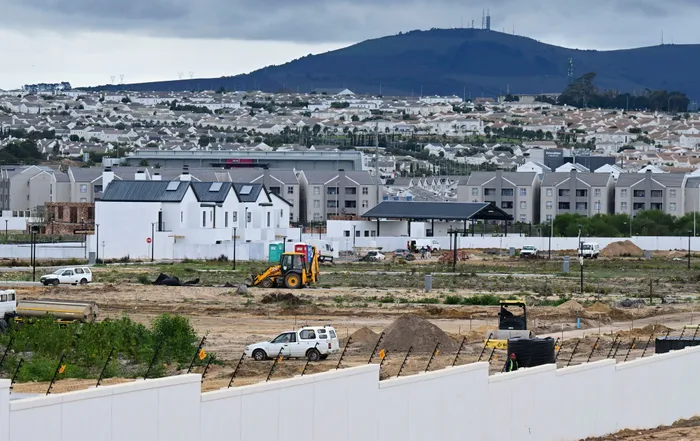Where is South Africa's residential property market headed in the final quarter of 2025?

The recent interest rate cutting cycle signals a stabilising economic environment, giving developers greater confidence to launch projects that were previously on hold.
Image: Henk Kruger / Independent Newspapers
South Africa's residential property market is entering a decisive chapter.
After several years of macroeconomic volatility, we are witnessing a convergence of forces that make this an unusually opportune moment for long-term property investment, says Reinier van Loggerenberg, CEO at Craft Homes.
Interest rates cut
He says interest rates are easing and a new wave of well-positioned, high-yield developments is redefining the landscape for investors and first-time buyers alike.
“At Craft Homes, we’ve had a front-row seat to these shifts. As a developer focused on quality residential spaces in strategic growth nodes, we’re seeing increased demand from a new generation of buyers: young professionals, remote workers and global investors who understand the structural value of location, convenience and long-term rental potential.”
The residential developer says the South African Reserve Bank's decision to lower the prime lending rate to 10.75% following four consecutive cuts from its peak of 11.75% has created a crucial affordability window.
It says for many would-be buyers, this means the difference between staying in a rental cycle and building equity in a long-term asset. It also signals a stabilising economic environment, giving developers greater confidence to launch projects that were previously on hold, the company says.
Property investments
It adds that lower rates are catalysing a wave of institutional investment into build-to-rent and mixed-use projects, particularly in areas with strong transport infrastructure and employment hubs.
“The result is a dual advantage: higher potential rental yields and increasing asset values, especially in metros like Johannesburg and Cape Town.”
With the hybrid and remote work models persisting, Craft Homes says the definition of a "prime location" is evolving. It says buyers and renters are seeking properties that offer both lifestyle benefits and logistical practicality - close to work, education, healthcare and retail.
“Iconic, for example, strategically positioned in the Melrose node, one of Johannesburg’s most resilient urban precincts, is attracting strong rental interest. Launching soon, it will have nearby access to the Gautrain, commercial offices and world-class amenities.
"For investors, this translates into reliable occupancy and above-average gross yields. As does The Hive in Rosebank with its studio apartments perfect for singles and new couples.”
In Sandton, the demand for well-priced, high-spec apartments remains high, particularly in secure complexes that appeal to executives and corporate tenants, says the developer.
Similarly, it says Midrand continues to offer compelling value due to its connectivity to both Johannesburg and Pretoria via the Gautrain and the N1 corridor.
“The area has emerged as a middle-income rental hub, with gross yields averaging between 10% and 13%, supported by consistent tenant demand from nearby business parks and distribution centres.”
Purpose-built rentals demand
According to van Loggerenberg, a noticeable trend is the growing demand for purpose-built rental stock, designed from the ground up to meet the needs of modern tenants.
“These aren’t traditional rental homes; they are integrated lifestyle precincts with on-site co-working, high-speed internet, gyms and communal spaces. These developments are seeing strong uptake precisely because they cater to this new kind of renter: one who seeks flexibility without sacrificing quality.”
He adds that this has also created an opportunity for investors looking for stability.
“Purpose-built rental properties tend to have lower vacancy rates and higher retention, particularly in professionally managed schemes. As an investment class, they offer strong defensiveness in a volatile macro environment.”
Sustainability in property
The company says sustainability is another driver of value as increasingly, tenants and buyers are gravitating toward properties that offer green credentials, not just for environmental reasons, but for long-term savings on energy and water costs.
“Our projects now routinely integrate green certification standards, solar-ready installations, metered back-up water systems, LED energy-saving lights and water restriction sanitary ware.”
It says that in a market where utility costs continue to rise and municipal infrastructure is under strain, these features are becoming essential. Investors should look at these as a hedge against operating risk and a signal of future-proof design, it says.
Affordability
Advising those considering entering the property market, Craft Homes says conditions are aligned. It says affordability is improving, strategic nodes are maturing, and consumer preferences are shifting in ways that benefit smart, long-term investment.
“My advice to prospective investors is simple: don’t just look at price. Look at placement. Is the development within reach of major transport? Is it near employment centres, lifestyle amenities, or educational nodes?
"Does it offer flexible living options that appeal to a range of tenants? And crucially, does the development team have a track record of quality delivery and long-term asset management?”
The CEO says the country is entering a new era of residential investment in South Africa that values smart density, infrastructure integration and lifestyle alignment.
“The best investments now are those that anticipate where people want to live five or ten years from now,”
However, in October this year, MultiNET Home Loans said affordability remains a critical challenge. It said many middle-income households are priced out of prime areas, creating growing interest in secondary towns and value-driven suburbs.
At the same time, “deal leakage”, where transactions collapsed due to financing rejections or compliance issues-continued to be a notable headwind in the market.
Outlook
Looking ahead, the homebuyers and property professionals' solutions provider said the property market will largely depend on credit conditions and broader economic stability. It said a stable or slightly lower interest rate environment could unlock more demand, but affordability gaps are likely to persist.
For investors and homeowners, success will hinge on understanding local market dynamics rather than relying on national averages.
“As we move into Q4, the property market is entering a period where differentiation matters more than ever. Strong micro-markets will continue to thrive, while affordability challenges in other segments will require innovative financing solutions.”
Independent Media Property
Related Topics: